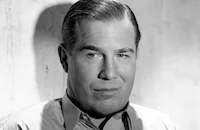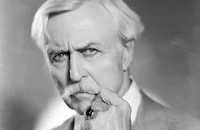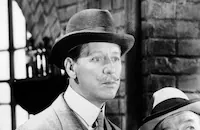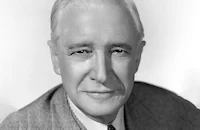Lady for a Day

Brief Synopsis
Cast & Crew
Frank Capra
Warren William
May Robson
Guy Kibbee
Glenda Farrell
Ned Sparks
Film Details
Technical Specs

Synopsis
Apple Annie, a cantankerous fruit peddler in New York, is patronized by Dave the Dude, a gambling gangster who believes that her apples bring him good luck. Unknown to anyone, Annie has a daughter, Louise, who is in a Spanish convent. With the aid of Oscar, the doorman at the Hotel Marberry, Annie has been sending letters to Louise on the hotel's stationery, thereby leading the girl to believe her mother is a high society matron named Mrs. E. Worthington Manville. Annie's crisis begins when she discovers that Louise is coming to New York so that her fiancé Carlos, and his father, Count Romero, can meet her. Meanwhile, Happy McGuire, Dave's right-hand man, and Dave are searching for the missing Annie when Annie's beggar friends arrive at Dave's apartment, relating Annie's tale of woe. After checking on Annie in her apartment, where he sees a photograph of Louise, Dave is asked by Annie's friends to help rent an apartment at the Marberry for Annie with the money they raised. Dave declines, but Happy soon finds him at the Marberry, where he is installing Annie in a borrowed apartment. Dave's paramour, nightclub owner Missouri Martin, helps transform Annie into the image of a proper society matron. Satisfied with the results, the men try to leave, but Missouri reminds them that Annie needs a husband. Dave suggests Judge Henry D. Blake, a smooth-talking pool hustler, who readily agrees to pose as Judge Manville after seeing the newly beautified Annie. Soon, Annie and the others greet Louise's ship, and Annie has a tearful reunion with her daughter. As Blake steers the company to waiting cars, Happy temporarily kidnaps a snoopy reporter, while the rest of the gang start a fight to distract the police from Dave's presence. After three happy days, the visitors are delighted when Blake announces, in front of Dave, that he and Annie will host a reception for them on the night they leave for Spain. Dave is disgruntled but promises to help, and after kidnapping three more insistent reporters, he begins planning the reception. Blake suggests that Dave's "mugs" and Missouri's "girls" pretend they are society swells and he writes speeches for them while Dave rehearses their manners. The next morning, police inspector MacCreary chastises his captain for not finding the missing reporters, and is reprimanded himself by the inspector, who in turn gets it from the commissioner, who is threatened by the mayor, and they all vow to fire their subordinates if the problem is not resolved. To further complicate matters, the first reporter Happy kidnapped comes in and implicates Dave. Later, on the night of the reception, the police surround Missouri's club, where the gang has assembled for a final rehearsal. Meanwhile, at Annie's apartment, Blake bets the count double or nothing on a game of billiards for Louise's dowry. Blake wins, but his jubilation sours when Dave calls to inform him that they are trapped at the club. Annie overhears the conversation, despairs and goes to confess to the count. MacCreary, meanwhile, arrests Dave, but Dave threatens that the reporters will never be seen again if he cannot carry out the night's plans. MacCreary then takes Dave to the mayor, who is hosting a party for the governor. Dave explains the situation and just as Annie is about to tell the count, Carlos and Louise the truth, the governor, the mayor and their guests arrive, pretending to be Annie's guests. The reception is a success, ending with the governor giving the visitors a police escort to their ship. On the way, each superior tells his subordinate that all is well, and the returned reporters are instructed to say that they were out on a drunk, thereby absolving Dave and preserving Annie's charade.

Director

Frank Capra
Cast

Warren William

May Robson

Guy Kibbee

Glenda Farrell

Ned Sparks

Walter Connolly

Jean Parker

Nat Pendleton
Barry Norton

Hobart Bosworth
Robert E. O'connor
Wallis Clark

Halliwell Hobbes

Irving Bacon

Samuel S. Hinds

Ward Bond
Crew
Bakaleinikoff
André Barlatier
E. L. Bernds
George Brown
Harry Cohn
Charles C. Coleman
William Fraker Jr.
Stephen Goosson
George Hager
Gene Havlick
Robert Kalloch
George Kelly
Buster Libbitt
Jimmy Lloyd
Charles Nelson
George Rhein
Robert Riskin
Joseph Walker
Michael Walsh

Photo Collections
Videos
Movie Clip




Hosted Intro
Film Details
Technical Specs

Award Nominations
Best Actress
Best Director
Best Picture
Best Writing, Screenplay
Articles
Lady for a Day
Initially Capra had some misgivings about taking on the project. According to Joseph McBride in his biography, Frank Capra: The Catastrophe of Success, the director told Columbia's studio boss, "Harry, I want you to face the fact that you're spending three hundred thousand dollars on a picture in which the heroine is seventy years old." To which the mogul replied, "All I know is the thing's got a wallop. Go ahead." Yet, despite the green light on the project, Capra had trouble with the casting. None of his top choices were available or interested; he wanted Marie Dressler for Apple Annie, Robert Montgomery, James Cagney or William Powell for Dave the Dude, and W.C. Fields for "Judge" Blake; instead he got May Robson, Warren William and Guy Kibbee, respectively, and they turned out to be perfect for their roles.
As for Damon Runyon, he was very pleased with the changes made to his original story. According to Joseph McBride's aforementioned biography, Runyon "wired profuse appreciation to Riskin for his manifold improvements in the story, and after reading press commentaries describing himself as the 'author' of Lady for a Day, Runyon went on public record in a February 1935 interview: "I wish you would quote me that Lady for a Day was no more my picture than Little Miss Marker, which, like the former picture, was almost entirely the result of the genius of the scenario writers and the director who worked on it."
Lady for a Day was one of the first pictures to team director Frank Capra and writer Robert Riskin. The two worked together on nine films, including such classics as It Happened One Night (1934), Mr. Deeds Goes to Town (1936), and Meet John Doe (1941). Capra also made four other films based on Riskin's work and the screenwriter always received sole credit for the scripts he wrote for Capra, but the director, particularly in his later years, sometimes implied he had more to do with the scripts than Riskin. According to McBride, "Capra stated his case even more bluntly in a 1977 debate on the issue in the Los Angeles Times with screenwriter and Writers Guild of America president David Rintels. Rintels attacked Capra for spreading his 'one man, one film' theory at Riskin's expense in his writings, interviews, and college lectures, and wrote that 'it is indecent of Capra to call Riskin one of his dearest friends while doing everything possible to undermine his reputation.'"
In the beginning, Riskin didn't mind Capra taking most of the credit for their films, but over time he grew to resent it. Eventually, the two went their separate ways in the forties. But by this time, the "Capraesque" film was established, and many of the director's later films continued the same themes as those in Riskin's scripts. Philip Dunne, a screenwriter and friend of Riskin's, once said of the Capra - Riskin team, "Frank provided the schmaltz and Bob provided the acid. It was an unbeatable combination. What they had together was better than either of them had separately."
Lady for a Day was the first film for which Capra received an Academy Award nomination for Best Director and the first time Columbia Pictures scored a Best Picture Oscar nomination. The film was also nominated for Best Actress (May Robson) and Best Adapted Screenplay (Riskin). The 36-year-old Capra desperately wanted to win an Oscar and he was convinced Lady for a Day would win in all four categories. The night of the awards, host Will Rogers opened the envelope for Best Director and said, "Well, well, well, what do you know! I've watched this young man for a long time¿It couldn't happen to a nicer guy. Come up and get it, Frank!" Capra's table broke out in applause as the director made his way to the stage. Then Capra realized the spotlight didn't stop on him, but on Frank Lloyd, director of Cavalcade (1933). Capra recalls in his autobiography, "That walk back -- through applauding V.I.P.s yelling 'Sit down! Down in front! Sit down!' as I obstructed their view -- was the longest, saddest, most shattering walk in my life. I wished I could have crawled under the rug like a miserable worm. When I slumped in my chair I felt like one. All my friends at the table were crying." Lady for a Day did not receive any awards that night. May Robson lost out to Katharine Hepburn in Morning Glory. Capra was so devastated and bitter he declared he would not return to the Oscars ceremony even if he were nominated again. The following year, however, Capra did return and he made history when It Happened One Night swept the awards for Best Picture, Director, Adapted Screenplay, Actor, and Actress.
Lady for a Day performed extremely well at the box office, bringing in $600,000, a large sum for 1933. Columbia employees recall that after its success, pencils and paperclips were readily available. Previously they had to requisition them. Lady for a Day was followed by a sequel, Lady by Choice (1934), starring Carole Lombard and directed by David Burton. Capra later remade Lady for a Day as Pocketful of Miracles (1961) with Bette Davis.
Producer/Director: Frank Capra
Screenplay: Robert Riskin. Based on story by Damon Runyon.
Cinematography: Joseph Walker
Art Direction: Stephen Goosson
Music: C. Bakaleinikoff
Principal Cast: Warren William (Dave the Dude), May Robson (Apple Annie), Guy Kibbee (Judge Blake), Glenda Farrell (Missouri Martin), Ned Sparks (Happy), Jean Parker (Louise), Walter Connolly (Count Romero), Nat Pendleton (Shakespeare), Hobart Bosworth (Governor), Barry Norton (Carlos Romero).
BW-96m.
by Deborah L. Johnson

Lady for a Day
Quotes
Trivia
Notes
The working titles of this film were Apple Annie, Madam La Gimp and Beggar's Holiday. According to Hollywood Reporter news items, Columbia attempted to obtain William Powell for the part of Dave the Dude, and Allen Jenkins, who was to be lent by Warner Bros. for an unspecified role, was granted a three-week layoff on his contract, and was therefore not included in the film. Warner Bros. did loan Warren William, Guy Kibbee and Glenda Farrell to Columbia for the film, while May Robson, Walter Connolly and Jean Parker were borrowed from M-G-M. Hollywood Reporter news items stated that Kit Guard and Pat Hartigan were added to the cast, but their participation in the final film has not been verified. According to Daily Variety and New York Times, Columbia took seventy-three-year-old Shubert Alley apple seller Ellen McCarthy to the film's premiere at Radio City Music Hall, after treating her to a stay at an expensive hotel and a new wardrobe. The publicity stunt was highly successful and was repeated in dozens of other cities, but was later criticized when "Mrs. McCarthy and her husband were found dead a year later from gas in the tiny flat where they had been existing on home relief." The film received four Academy Award nominations, for Best Picture, Best Actress, Best Writing and Best Direction, which was Frank Capra's first nomination. It was also selected by the Film Daily Poll of Critics as one of the ten best pictures of 1933. In the June 1933 International Photographer news item from which some technical credits were obtained, George Rhein's name is spelled Rhine, and George Hager's name is spelled Hagger. Modern sources list additional cast member Dad Mills as Shultzie, the blind man. On May 1, 1939, May Robson and Jean Parker performed a radio version of Lady for a Day for Lux Radio Theater. Capra's last feature film was the 1961 remake of this film, entitled Pocketful of Miracles, starring Bette Davis and Glenn Ford (see AFI Catalog of Feature Films, 1961-70; F6.3870).















